When Hurricane Maria ravaged Puerto Rico in September, you could calculate the devastation in many ways. The financial ruin, initial estimates said, was at minimum $30 billion. The time it would take to restore energy to the island was estimated to be between four to six months. But the number of people who died in the storm was comparatively low—just 62, according to government statistics. New data suggests that last number is likely wrong. While Puerto Rico’s official numbers place the death toll at under 100, data published by the New York Times on Friday projects that the dead might number as high as 1,052. That’s almost 17 times higher than the official count.
The number of people who died as a direct result of the storm’s waves and winds is probably similar to the government count. But as the Times reports, the storm’s effects reverberated long after the eye passed over the island. For example, on Sept. 25 of this year, five days after the storm, 135 people died on the island—up from 75 on the same day in 2016. “It was over 90 degrees, and power was out on most of the island, even in most hospitals,” the Times writes of that day. “Bedridden people were having trouble getting medical treatment, and dialysis clinics were operating with generators and limiting treatment hours. People on respirators lacked electricity to power the machines.” A similar disaster had just played out to the north. When Hurricane Irma hit Florida less than two weeks before, some 160 nursing homes lacked electricity: At one home, eight elderly patients died, and several more died after an emergency evacuation.
Heat wasn’t the only problem, of course. Sepsis exploded as a cause of death in the aftermath of Maria, with 92 people dying of the disease in September 2017 compared to 61 the previous year—a 47 percent increase. Sepsis is caused when harmful bacteria overpowers the body, shutting down organs. The bacteria commonly enters a person’s body through open wounds. Hurricanes are known to cause infection in their aftermath, especially when septic tanks and other waste spill into floodwaters, which people are then forced to wade through as they seek shelter. As the Times notes, in the aftermath of Maria, rates of death associated with pneumonia, an infection of the lungs, also spiked.
Sept. 25 was the deadliest day analyzed in the Times report, a full five days after Maria made landfall. It’s hard to definitively assert that these deaths were the direct result of the hurricane, rather than a natural fluctuation; it’s a small sample size, and lines of causation are hard to draw. Indeed, that may be why the official counts have left it at 62—officials have insisted that additional deaths were the result of natural causes, not the storm itself. But for those following the aftermath of Maria, some kind of recalibration has been expected. On Oct. 11, Vox published one of the first pieces challenging official data. Its piece, titled “Everything that’s been reported about deaths in Puerto Rico is at odds with the official count,” argued at least 450 were dead, maybe more. On Thursday, the Center for Investigative Reporting first reported the results of a study that counted at least 1,065 Maria-related deaths.
It’s not just the lines of causation that are hard to track. In the wake of the storm, record keeping was extremely complicated: The disruption to electricity meant death counts had to be tallied without reliable internet or cellphone service. And because the bodies piled up so fast, they were harder to track. So it’s possible that even the records the Times is using in its corrections still underestimate the uptick—and it’s possible that not every additional death should be attributed to the storm. Either way, there’s still a lot of gruesome math to be done before we truly understand one of the most important statistics from this disaster.
